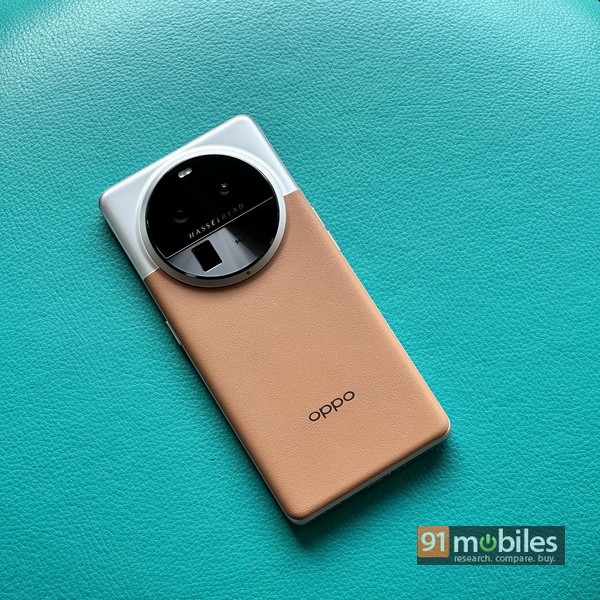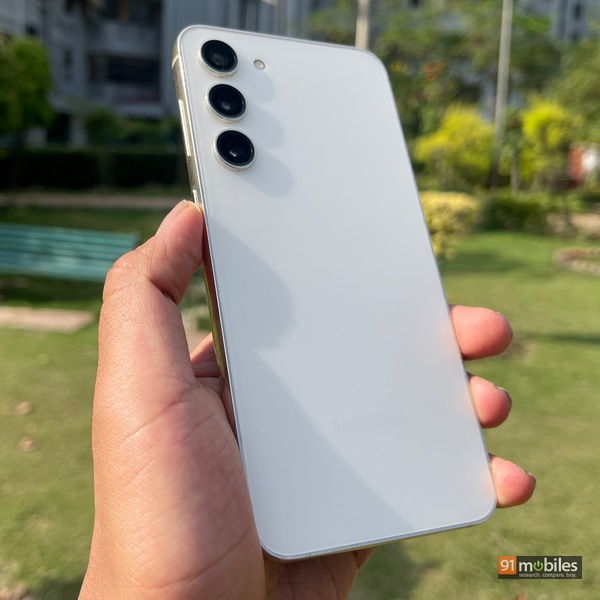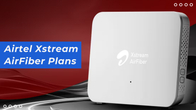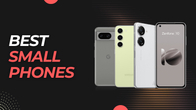Every year lot of mobile phones launch, and it can be a difficult task to narrow down the best phone in the world. This article here is an attempt to help you with that. We have curated the list of the best smartphones in the world right now. The handsets have been picked based on their performance, which has been the most sought-after based on our research, along with camera quality, display, and battery backup. The data is duly supported by various benchmarking platforms such as AnTuTu and DXOMark, ensuring that you get the absolute best smartphone value for the price.
Samsung Galaxy S24 Ultra
- Samsung Galaxy S24 Ultra (review) headlined news at launch for its AI features like Circle to Search, Live Translate, Chat Assist, Interpreter, fill image, etc.
- Under the hood, the phone comes with a Snapdragon 8 Gen 3 SoC, up to 12GB RAM, up to 1TB storage, and a 5,000mAh battery with 45W fast charging support.
- On the back, there is a 200MP primary camera coupled with a 10MP 3x telephoto, 50MP periscope 5x zoom, and a 12MP ultrawide shooter.
- On the front, it has got a 6.8-inch LTPO AMOLED screen with 3120x1440p resolution, 120Hz refresh rate, 2,600 nits of peak brightness, HDR10+ support, and Gorilla Glass Armor protection.
![]()
| Pros | Cons |
- AI features
- Strong performance and battery life
- Good display and cameras
- S Pen is a unique feature
| |
OPPO Find X6 Pro
- OPPO Find X6 Pro packs a 4nm Snapdragon 8 Gen 2 SoC coupled with up to 16GB LPDDR5x RAM, 512GB UFS 4.0 storage, and Adreno 740 GPU. For faster performance, you can turn on the High-Performance Battery mode. Thanks to this, the device has clocked an AnTuTu score higher than every other phone in this list except the Vivo X100 Pro.
- The OPPO phone has a 50MP+50MP+50MP triple rear camera setup. One of these lenses offers 2.8x optical zoom. With AI enhancement, you can get up to 120x zoom. The colour spectral sensor and Hasselblad’s Natural Colour Calibration ensure a proper white balance. All sensors put out well-detailed, evenly-focussed shots in different lighting scenarios with good dynamic range. You also get Dolby Vision HDR video capturing at 4K30fps and high-efficiency photo and video capturing.
- On the front, the device sports a 6.82-inch LTPO3 AMOLED screen with 510ppi, 1-120Hz adaptive refresh rate, 800-nits typical brightness and Gorilla Glass Victus 2 protection. It is a fairly colour-accurate panel with Dolby Vision and HDR10+ certification.
- Inside, it has a 5,000mAh battery with 100W wired charging, 50W wireless charging and 10W reverse wireless charging support. OPPO claims the device can be topped up full in half an hour using the wired adapter.
![]()
| Pros | Cons |
- Attractive design and beautiful display
- Dependable cameras
- Fluid performance
- Decent battery life, fast charging
| |
iPhone 15 Pro
- Apple has equipped the iPhone 15 Pro with a 3nm A17 Pro chipset. This is paired with a 6-core GPU, 8GB RAM and 1TB storage. There is support for hardware-based ray tracing for games. There is also out-of-the-box support for console games like Resident Evil Village, Resident Evil 4 Remake, and Assassin’s Creed Mirage. If you want a pro-grade iPhone, then this one offers a better upgrade compared to the Pro Max model.
- It has a 48MP main camera with sensor-shift OIS, 12MP 3x zoom, and a 12MP ultrawide snapper. By default, the main camera shots are saved in 24MP resolution. You can apply Photographic Styles to them. You can also take 48MP images in HEIF or JPEG format and 48MP ProRAW photos. From the 12MP front camera, you can take steady shots thanks to OIS. The iPhone 15 series continues to be the video camera king in the smartphone space and you can’t go wrong with any of these models.
- It sports a 6.1-inch screen which should be very ergonomic. It is OLED with Dolby Vision 460ppi pixel density, 1-120Hz variable refresh rate, 1000 nits of typical brightness, and Dynamic Island. It is great at colour accuracy, brightness, and smooth animations.
- The phone bears a 3,274mAh battery with a PD wired charger, 15W MagSafe charging, 15W Qi2 wireless charging, and 4.5W reverse wired charging. The smaller battery size is reflected in the DXOMark battery test. The PD charger also manages to fill the tank half in 30 minutes. So, if battery life is important for you, you can check out other phones in the list.
![iPhone 15 Pro]()
- AnTuTu: 15,58,415 | DXOMark Camera: 154 | DXOMark Display: 149 | DXOMark Battery: 114
| Pros | Cons |
- Reliable performance and support for console-level games
- Good display
- Impressive cameras for both photos and videos
| - Battery life and charging speed leaves a lot to be desired
|
Samsung Galaxy S23 Ultra
- On the Android side, the Galaxy S23 Ultra has to be the phone that’s available in all markets. It won the Best Phone award in the premium segment in last year’s Indian Gadget Awards. If you value brand recognition and the aftersales service assurance you get with it, you can check out this device. It ships with Snapdragon 8 Gen 2 SoC, Adreno 740 GPU, up to 12GB LPDDR5x RAM and 1TB UFS 4.0 storage.
- The phone features a 200MP primary camera, accompanied by 12MP ultrawide, a 10MP telephoto with 3x optical zoom, and another 10MP telephoto with 10x optical zoom. Digitally, it is capable of capturing up to 100x zoom. The photos present good details and colours, Even though the front camera sensor resolution has been downgraded to 12 megapixels, the phone can leverage new features like dual-pixel autofocus and Super HDR.
- The fascia is 6.8 inch AMOLED. Samsung flagship phones are known for their panel quality. The same is true for this handset. It is plenty bright, has vibrant colours, 120Hz adaptive refresh rate, QHD+ resolution, and Gorilla Glass Victus 2 protection.
- It has a 5,000mAh battery with 45W wired charging, 15W wireless, and 4.5W reverse wireless charging support. Possibly thanks to the chip’s efficiency, the battery life is too good. The charging speed is agreeable at 65 percent in 30 minutes.
![]()
- AnTuTu: 15,51,689 | DXOMark Camera: 140 | DXOMark Display: 148 | DXOMark Battery: 142
| Pros | Cons |
- Vibrant and smooth display
- Great cameras, especially for photos
- Capable performer
- Long-lasting battery life
- S Pen
| |
Samsung Galaxy S23+
- It isn’t far from the performance you get on the S23 Ultra since both phones carry the same Snapdragon 8 Gen 2 chipset. This is roomed with 8GB of LPDDR5X RAM along with 256GB/512GB UFS 4.0 storage.
- The 50MP main camera and the 12MP ultrawide have similar colour tones. The results are great for the most part but you may face occasional shutter lags and soft details in lowly-lit conditions. The night mode on all three sensors can bring out the best results in these settings. The 10MP telephoto lens can produce 3x optically zoomed results. The front 12MP camera can take sharp and detailed shots.
- The 6.6-inch AMOLED display on the S23+ is also remarkable with HDR10+ certification, sufficient brightness in all situations, 393ppi pixel density, and Gorilla Glass Victus 2 protection.
- The Plus in the name is for the bigger display and the larger 4,700mAh battery. We were getting more than 6 hours of screen-on time during the review time. It is backed by 25W wired charging (rated to refill the tank up to 65 percent in half an hour), 15W Qi wireless and 4.5W reverse wireless charging.
![]()
- AnTuTu: 15,51,358 | DXOMark Camera: 133 | DXOMark Display: 146 | DXOMark Battery: 134
| Pros | Cons |
- Assuring performance
- Great set of cameras
- Good battery life
- Large and sultry display
| - Charging speed limited to 25W
- Occasional shutter lags
|
iPhone 15 Pro Max
- iPhone 15 Pro Max is also equipped with the A17 Pro SoC with a 6-core CPU and 6-core GPU. It sports support for AAA games like Resident Evil Village and Assassin’s Creed Mirage. The performance is backed by 8GB LPDDR5 RAM and 1TB of NVMe storage.
- The rear camera setup consists of a 48MP main camera, a 12MP 5x optical zoom lens, and a 12MP 120° ultrawide snapper. There is also a ToF 3D LiDAR scanner here. The increase in zooming capability, stable shots and videos, and the option to apply the bokeh effect to shots after the face are also very interesting.
- Compared to the iPhone 15 Pro, you get a larger 6.7-inch OLED screen. It also features Dolby Vision, 460ppi pixel density, 1000 nits of typical brightness, 1-120Hz adaptive refresh rate, and Dynamic Island. The colours and contrasts are well-calibrated.
- This phone can give you one of the most impressive battery life from a modern smartphone. The 4,441mAh battery enables this aided by PD charging, 15W MagSafe and 15W Qi2 wireless charging.
![Apple-iPhone-15-Pro-Max-in Natural Titanium]()
- AnTuTu: 15,46,274 | DXOMark Camera: 154 | DXOMark Display: 149 | DXOMark Battery: 134
| Pros | Cons |
- The new design makes it slightly smaller and lighter
- Smooth performance
- Excellent cameras for both videos and photos
- USB-C
| - Action button performs 1 task
- Charging speeds are not fast enough
|
iPhone 15 Plus
- If you don’t care about the Pro lineup features, but still want a long-lasting and powerful iPhone, the iPhone 15 Plus could be worth a look. It is armed with an Apple A16 Bionic chipset, 6GB RAM and 512GB storage. Our reviewer found it to be extremely snappy at performing whatever tasks he wanted it to do.
- The 48MP camera shots are good-looking with some lean towards warm tone. The 12MP ultrawide produces comparable clicks in good light. The ability to turn regular photos into portraits from the Photos app can prove handy.
- Even the vanilla iPhones got Dynamic Island this generation. But still no high refresh rate or AoD option. If you like a larger display, here you get a 6.7-inch OLED panel with 1000 nits typical brightness, Dolby Vision, and 460-ppi pixel density.
- The highlight of the phone besides that big screen is its big battery life. Our reviewer was getting 6-7 hours of screen-on time which is commendable. The batter size is 4,383 mAh and the charging speed is 27 watts from the wired charging option. This takes about 2 hours to fill the tank. You can also use 15W Qi2 and MagSafe chargers for wirelessly topping it up.
![]()
- AnTuTu: 14,07,757 | DXOMark Camera: 145 | DXOMark Display: 144 | DXOMark Battery: 131
| Pros | Cons |
- Ergonomic
- Stellar battery life
- Bright and attractive display
- Good cameras
| - Lacks a high refresh rate
- Slow charging
|
Xiaomi 13 Pro
- Xiaomi 13 Pro is engined by a Qualcomm Snapdragon 8 Gen 2 chipset along with 12GB of LPDDR5X RAM. You can pick it up in 256GB and 512GB storage variants. That should be plenty of storage and dependable performance from the device.
- Xiaomi has carried over the 50MP 1-inch type sensor from the Xiaomi 12S Ultra. This coupled with the Leica lens and image pipeline creates highly-detailed and well-exposed photos. Further, you can opt for Leica Vibrant, 35mm black and white images, and other image filter options. The ancillary sensors are a 50MP telephoto shooter (with 3.2x optical zoom) and a 50MP ultrawide snapper. The results are good in the case of both photos and videos.
- The 6.73-inch LTPO OLED display is faithful to DCI-P3 and sRGB colour gamuts. It delivers 522ppi pixel density and is a lot bright too. You also get up to 120Hz adaptive refresh rate and support for Dolby Vision content.
- The 4,820mAh battery gives 6 hours of screen-on time in our review time. It can easily last for 1.5 days and when it begs for the charge, plug in the 120W fast charger and the thing should be back to full energy in 19-25 minutes.
![Xiaomi 13 Pro]()
- AnTuTu: 12,53,206 | DXOMark Camera: 136 | DXOMark Display: 136 | DXOMark Battery: 126
| Pros | Cons |
- Impressive display
- Robust performance
- High-quality rear cameras
- Stupid fast charging
| - Room for improvement in the selfie camera
- Occasional heating issues
|
Google Pixel 8 Pro
- Google Pixel 8 Pro runs on the in-house Tensor G3 chipset. This is one of the shortcomings of the Pixel 8 series. For everyday use, it may be fine but is behind the current and last-gen flagships. It throttles and gets warm in long time usage. However, the near-stock Android, Pixel-exclusive software features and AI goodies are its attractions. The RAM options of up to 12GB and storage of up to 1TB should make the experience passable.
- Some of those AI trickeries appear in the photography department. Some of the tools at your disposal will be Magic Eraser, Best Take, and Magic Editor. Even without them, the 50MP+48MP+48MP triplet is impressive in taking photos. The colours and details seem close between the main and ultrawide sensor outputs. The 5X zoom also retains good clarity. The videos can’t still take on the results from the current-gen iPhones though.
- Google has put a gorgeous 6.7-inch OLED panel on the front with 489ppi pixel density, 120Hz refresh rate, HDR10+ support, and decent colour accuracy. It is amazingly bright.
- It has got a large 5,050mAh battery and it can last for a day’s use. That size leaves you wanting for more though. The 30W adapter isn’t fast enough as it could take about 2 hours to fill the battery from 0-100.
![]()
- AnTuTu: 11,61,332 | DXOMark Camera: 153 | DXOMark Display: 154 | DXOMark Battery: 111
| Pros | Cons |
- Extended 7-year OS support
- Close-to-stock Android experience
- Camera features powered by AI
- Standout design
| - Some throttling and heating
- Slow charging
|
Google Pixel 8
- The performance on the Pixel 8 is driven by the Tensor G3 only and so the real-world experience won’t be that different. In our review period, we didn’t find any major lags or hiccups but there were some throttling and heating issues. The synthetic test scores were also mid-range, not flagship-level. The good things like its software experience aided by AI, up to 8GB RAM and 256GB storage are the silver lining.
- The shots from the 50MP main camera and the 12MP ultrawide snapper are pleasing. The latter does suffer from softened details around the edges of the frame. There is no telephoto but digital zoom up to 2x is passable. The photos also benefit from built-in AI tools like Magic Eraser, Best Take, and Magic Editor.
- Like the Pro, the 6.2-inch OLED screen on the front is great to look at. It presents 428ppi pixel density, 120Hz refresh rate, HDR10+ support, and respectable colour representation. It is a lot bright too.
- The 4,575mAh battery gave us 5 hours of screen-on time during the testing time. The 27W wired charger can juice up the device from 0 to 100 in about 1 hour and 23 minutes.
![]()
- AnTuTu: 10,83,601 | DXOMark Camera: 148 | DXOMark Display: 154 | DXOMark Battery: 103
| Pros | Cons |
- Advanced AI tools
- Attractive design
- Respectable battery life
- Excellent software support
- A great option for photography
| - Slow charging
- Performance could have been better
|
Other top phones of 2024
Vivo X100 Pro
- Vivo X100 Pro (review) is running on a 4nm Mediatek Dimensity 9300 chipset with all cores tuned for performance. It thus clocks a 2,010,948 AnTuTu score and is easily one of the fastest phones out there.
- The Vivo X series is known for its camera chops. It is equipped with a 50MP main camera, accompanied by a 50MP ZEISS APPO Floating Periscope lens and a 50MP ultrawide shooter. For selfies, you get a 32MP sensor.
- On the front, there is a 6.78-inch 120Hz AMOLED display with 1260 x 2800 pixel resolution and 3000 nits of peak brightness.
- Keeping the lights on is a 5,400mAh battery with 100W fast charging and 50W wireless charging support.
![]()
- AnTuTu: 2,010,948 | DXOMark Camera: 150
| Pros | Cons |
- Great rear cameras
- Striking display
- Impressive battery longevity
- smooth performance
| - Slippery build
- Selfie performance needs work
|
Xiaomi 14 Ultra
- Xiaomi 14 Ultra ships with Snapdragon 8 Gen 3 SoC and scores 20,20,176 in the AnTuTu benchmark. This is aided by 16GB of LPDDR5X RAM and 512GB of UFS 4.0 storage.
- In our review, we said Xiaomi 14 Ultra is all about cameras. On the back, there is a 50MP camera with OIS, a 50MP 3.2x optical zoom telephoto camera with OIS, a 50MP 5x optical zoom telephoto camera with OIS and 120x digital zoom, and a 50MP ultrawide camera with auto-focus. On the front, there is a single 32MP selfie shooter.
- The front side also has a 6.73-inch LTPO AMOLED with 120Hz refresh rate, 1400×3200 resolution and 3000 nits of peak brightness.
- A 5000mAh battery keeps it on backed by 90W fast charging support.
![xiaomi_14ultra]()
| Pros | Cons |
- Versatile rear cameras
- Stunning display
- Super fast charging
- Long endurance
| - Hefty device
- Bloated software
|































